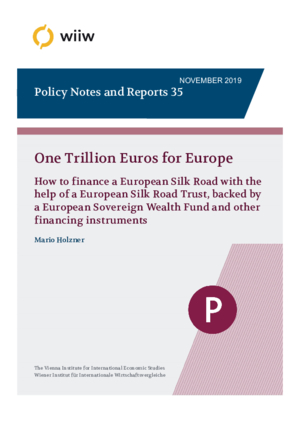One Trillion Euros for Europe. How to finance a European Silk Road with the help of a European Silk Road Trust, backed by a European Sovereign Wealth Fund and other financing instruments
wiiw Policy Note/Policy Report No. 35, November 2019
15 pages including 7 Figures
- Much of Europe’s infrastructure is in a bad state, even in some wealthy parts of Europe, such as Germany. Europe’s periphery is underdeveloped and has difficulties to catch up, in part because of substantial infrastructure deficiencies. Real interest rates are negative and infrastructure investment has the potential to finance itself. Current European infrastructure initiatives are insufficient and piecemeal.
- In this context, wiiw proposes a financing model for a European Silk Road, as suggested in Holzner et al. (2018). The new transport infrastructure (a combination of an e-mobility motorway, high-speed rail, ports and logistics centres) would connect the industrial areas of the west with the populous, but less developed, regions in the east of the continent.
- The estimated construction costs of 1 trillion euros (7% of EU GDP) should yield substantial short-, medium- and long-run economic gains along the route (11,000 km overland). Apart from the growth and employment effects of construction activity (2-7 million new jobs during the building period), trade effects are also expected to be significant.
- In order to conduct and finance the project, we propose establishing a European Silk Road Trust (ESRT) as a public limited company, similar to the Austrian ASFiNAG corporation. This would allow for the extra-budgetary financing of investment in infrastructure (and for the project’s operation).
- While the ESRT (owned by the euro area countries, other EU countries and third countries that wish to join in the construction of the European Silk Road) could rely on a public guarantee when it comes to issuing long-term bonds (at currently zero or even negative interest rates), it would formally be part of the private sector, especially as it would have sufficient income of its own from private customers (tolls).
- As a strong core guarantor for the ESRT, we suggest the gradual development of a European Sovereign Wealth Fund (ESWF) by the euro area member states. At a certain point in time, this fund could replace the euro area member states as the major guarantor for ESRT bonds.
- In the initial phase, the European Central Bank (ECB) could reinvest a part of its assets in a way that would (to a certain extent) carry more risk, but also bring greater revenues, following the structure of the Norwegian oil fund. It is estimated that the ESWF would grow over the longer term to about 3% of the euro area’s GDP. This should be sufficient to guarantee the ESRT bonds – even if long-term interest rates move back into positive territory in the more distant future.
- Alternative means of financing include a much smaller ESWF of about 0.7% of euro area GDP in the longer run, sourced from a part of the profits of the ECB, without changing the structure of the ECB’s asset purchase programmes. Other options, which would make use of existing institutions (instead of an ESWF) would include, for instance, a substantial increase in the European Fund for Strategic Investments (EFSI) and/or a larger capital injection in the European Investment Bank (EIB), in order to finance the ESRT’s activities.
- The likelihood of an increase in global interest rates anytime soon is minimal, considering the Japanese experience over recent decades. In the current macroeconomic climate, a ‘big push’ in infrastructure investment, such as the suggested European Silk Road project, could help to solve both the problem of sluggish growth in the west of the continent and the developmental problems in the east. Moreover, it could constitute a new narrative of cooperation for Europe.
Keywords: infrastructure, transportation, Europe, China, Silk Road, growth, economic integration. industrialisation, international trade, public finance, international financial policy, financial institutions
JEL classification: E61, F36, F38, F42, G18, G28, H54, O18, R41, R42, L92
Countries covered: CEE, CIS, Euro Area, European Union, New EU Member States, SEE, Wider Europe
Research Areas: Macroeconomic Analysis and Policy, Sectoral studies
